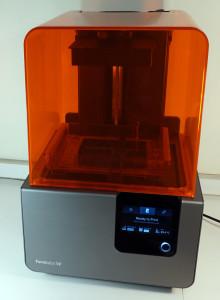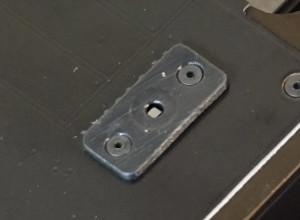 Stereolithography is actually one of the oldest varieties of 3D printing, with roots that go back all the way to the 1970s. However, before Formlabs launched their record-breaking nearly $3 million Form1 campaign on Kickstarter in 2013 the process was primarily the domain of stuffy industrial prototyping offices and industrial applications. But the Form 1 was an SLA printer made for the desktop, and Formlabs made it look damn sexy, something that at that point could rarely be said about most 3D printers. And despite being the first product from a new startup, the printer was both well-received and highly praised for its design and formfactor.
Stereolithography is actually one of the oldest varieties of 3D printing, with roots that go back all the way to the 1970s. However, before Formlabs launched their record-breaking nearly $3 million Form1 campaign on Kickstarter in 2013 the process was primarily the domain of stuffy industrial prototyping offices and industrial applications. But the Form 1 was an SLA printer made for the desktop, and Formlabs made it look damn sexy, something that at that point could rarely be said about most 3D printers. And despite being the first product from a new startup, the printer was both well-received and highly praised for its design and formfactor.
When it came time for the Massachusetts-based company to release its next model, after the Form 1+, Formlabs’ new Form 2 3D printer was an improvement over its predecessor in virtually every way imaginable. But how deep did the improvements go exactly? Legendary hardware hacker Andrew “Bunnie” Huang famously tore down a Form 1 a few years ago when he backed the original Kickstarter campaign and found himself impressed with the build quality. So when he got his hands on an engineering prototype of the Form 2, Bunnie decided to take the opportunity to look under the hood and see how the new model stacks up to the old.
What he found was a 3D printer packed with hardware that both improved on the build quality of the original and came up with some creative and smart solutions that kept the cost of the printer down without sacrificing quality. Unlike a lot of mass produced 3D printers, the Form 2 didn’t use the same build architecture as its previous iteration. Instead, they actually completely redesigned, re-engineered or upgraded several components entirely to prevent the new printer from inheriting limitations and flaws from the original. Bunnie contrasted the Form2 with the MakerBot Replicator 2, which didn’t bother to make the same changes and ended up with a printer that largely had the same problems as the previous models.
“The Form 2 is a quantum leap forward,” Bunnie explained. “The product smells of experienced, seasoned engineers; a throwback to the golden days of Massachusetts Route 128 when DEC, Sun, Polaroid and Wang Laboratories cranked out quality American-designed gear. Formlabs wasn’t afraid to completely rethink, re-architect, and re-engineer the system to build a better product, making bold improvements to core technology. As a result, the most significant commonality between the Form 1 and the Form 2 is the iconic industrial design: an orange acrylic box sitting atop an aluminum base with rounded corners and a fancy edge-lit power button.”
The first time Bunnie took apart a Formlabs printer he still had plans to use it, so he only went so far. But with the Form 2 engineering prototype being, essentially, spare parts, he decided to strip it down to the bones and found a ton of great, hidden features that most people would never know where in there. He found the expected massive CPU upgrades that enabled built-in wifi & ethernet, an all new UI that came with the new capacitive touch screen, and he found the four GB of on-board flash memory being used to store previous jobs so they can be quickly started over.
He also discovered a ton of quality hardware upgrades that weren’t in the Formlabs marketing materials. They included customized galvanometers, a fully shrouded optics pathway to avoid dust build up, several internal shrouds to prevent the same thing in other areas of the printer and internal optics protected by a new AR-coated glass surface. The resin tray was now auto-filling, auto-leveling thanks to the tilt sensor. It included a closed-loop controlled heater and a stirrer to prevent partially cured resin from thickening, and the resin tank also includes sensors to monitor the resin level and even remember what color resin is in the tank so users could avoid mixing materials.
“I’m also guessing there are a number of upgrades that are less obvious from a visual inspection, such as improvements to the laser itself, or optimizations to the printing algorithm. These improvements indicate a significant manpower investment on the part of Formlabs, and an incredible value add to the core product, as many of the items I note above would take several man-months to bring to production-ready status,” said Bunnie.
Among the more interesting features that Bunnie discovered was a resin temperature sensor mechanism that was mounted on the PCB behind the resin tank. He noted that it was obviously 3D printed on another Formlabs printer before being used on the engineering prototype, a clear sign that the Formlabs team has quite a bit of faith in their own hardware. He also found a really oddly shaped PCB that he discovered had a dual purpose. Not only did it hold the leafspring contacts for the resin tank monitoring ID chip, but when he flipped it over he discovered that the PCB was also a heating mechanism. Using a PCB in this way was quite an effective and low-cost solution to controlling the temperature of the resin during printing.
Bunnie also spends a lot of time talking about how smart the design, layout and placement of the Form 2’s mainboard was, pointing out that it had all the hallmarks of a smart engineering team that was keeping an eye on budget. Rather than a larger company with access to huge dev budgets, the Formlabs team is clearly a leaner operation and actually made design and hardware choices that kept costs down without sacrificing the integrity of their printer. They also obviously knew when to use the more expensive option because it would make the printer work better, as is the case of the injection molded polymer base.
“I’m oddly excited about the base of the Form 2,” said Bunnie. “It looks like just a humble piece of injection molded plastic. But this is an injection molded piece of plastic designed to withstand the apocalypse. Extensive ribbing makes the base extremely rigid, and resistant to warpage. The base is also molded using glass-filled polymer – the same tough stuff used to make Pelican cases and automotive engine parts. I’ve had the hots for glass-filled polymers recently, and have been itching for an excuse to use it in one of my designs. Glass-filled polymer isn’t for happy-meal toys or shiny gadgets, it’s tough stuff for demanding applications, and it has an innately rugged texture. I’m guessing they went for a bomb-proof base because anything less rigid would lead to problems keeping the resin tank level. Either that, or someone in Formlabs has the same fetish I have for glass filled polymers.”
Bunnie’s entire teardown is a fantastic read, even if you’re not especially familiar with all of the components that he talks about. He does a great job of explaining what the part that he’s talking about does, and why it’s notable and worth pointing out. It is a long read, but it is also a fantastic look inside of a quality consumer product written by someone who clearly loves to see the way that smart engineers solve hardware problems. You can check out the entire teardown blog post here. Are you surprised at what Bunnie found? Let’s talk about it over in the Form 2 3D Printer forum over at 3DPB.com.
Subscribe to Our Email Newsletter
Stay up-to-date on all the latest news from the 3D printing industry and receive information and offers from third party vendors.
You May Also Like
3D Printing News Briefs, April 13, 2024: Robotics, Orthotics, & Hypersonics
In 3D Printing News Briefs today, we’re focusing first on robotics, as Carnegie Mellon University’s new Robotics Innovation Center will house several community outreach programs, and Ugogo3D is now working...
Rail Giant Alstom Saves $15M with 3D Printing Automation Software 3D Spark
3D Spark has entered into a three-year deal with the rail giant Alstom. Alstom, a transport behemoth with annual revenues of $16 billion, specializes in the manufacture of trains, trams,...
Meltio Expands Global Reach with New Partnerships in the Americas and Europe
Spanish 3D printing manufacturer Meltio has expanded its sales network across the globe. With the addition of three new partners in the United States, Brazil, Argentina, and Italy, Meltio aims...
3D Printing Webinar and Event Roundup: April 7, 2024
Webinars and events in the 3D printing industry are picking back up this week! Sea-Air-Space is coming to Maryland, and SAE International is sponsoring a 3D Systems webinar about 3D...




































